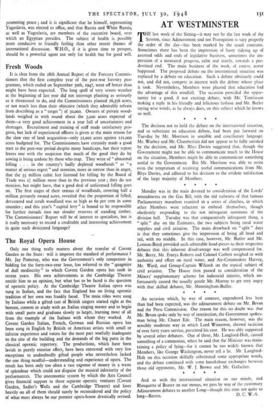Fresh Woods
It is clear from the 28th Annual Report of the Forestry Commis- sioners that the first complete year of the post-war forestry pro- gramme, which ended on September 30th, 1947, went off better than might have been expected. The long spell of very severe weather at the beginning of last year did not interrupt planting as seriously as it threatened to do, and the Commissioners planted 26,356 acres, or not much less than their objective (which they admirably refrain from describing as a " target ") of 30,000. Owners of private wood- lands weighed in with round about the 5,000 acres expected of them—a very good achievement in a year full of uncertainties and shortages. Recruitment and training of staff made satisfactory pro- gress, but lack of experienced officers is given as the main reason for the slow rate of land acquisition—only 22,000 acres against 121,000 acres budgeted for. The Commissioners have certainly made a good start to the post-war period despite many handicaps, but their report leaves one with the suspicion that much of the good they do by sowing is being undone by those who reap. They write of " abnormal felling . . . in the country's badly depleted woodlands " as " a. matter of serious regret " and mention, more in sorrow than in anger, that the 55 million cubic feet licensed for felling by the Board of Trade was 21 million more than in the previous year ; they do not mention, but might have, that a good deal of unlicensed felling goes" on. The first stages of their census of woodlands, covering half a million privately owned acres, revealed that the proportion of felled, devastated and scrub woodland was as high as 6o per cent in some counties ; and this year's " capital levy " is bound to be responsible for further inroads into our slender reserves of standing timber. The Commissioners' Report will be of interest to specialists, but is it really necessary to record a creditable and interesting achievement in quite such desiccated language?


































 Previous page
Previous page